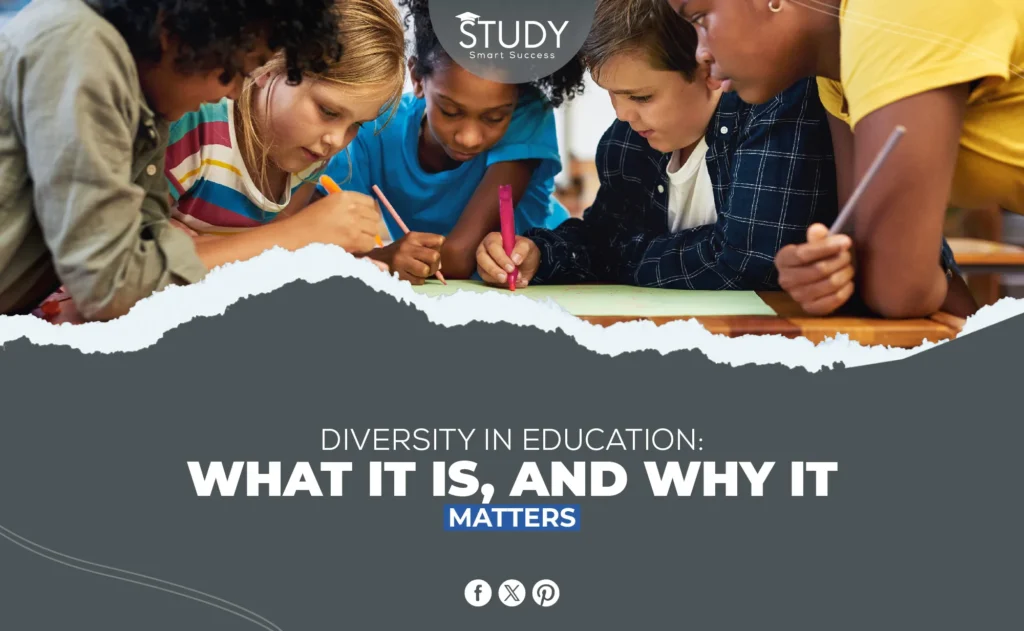Definition of Diversity in Education
Diversity in education means recognizing and praising the many ways students differ. It includes a wide range of things, not just differences in population. These include cultural backgrounds, socioeconomic situations, gender identities, abilities, and ethnicities. Diversity means recognizing and appreciating the unique things that make each student a particular person in the school community.
Significance of Diversity in Educational Settings:
There are many vital reasons why variety is essential in schools. It transcends the boundaries of conventional learning by fostering an environment where the richness of varied views, experiences, and identities is recognized and actively integrated into the educational fabric.
Diversity is a powerful tool for breaking down barriers, spreading inclusivity, and preparing students for a globalized world where understanding and appreciating differences are crucial life skills.

Various Dimensions of Diversity in Educational Settings:
Cultural Diversity:
Cultural diversity comprises many different practices, languages, beliefs, and habits. In schools, it means creating a place where kids from other cultures feel welcome and their points of view add to the overall learning process.
Socioeconomic Diversity:
Socioeconomic diversity recognizes that students come from different backgrounds financially. It includes students from various financial backgrounds and ensures that all students have the same access to educational tools and chances, no matter how much money they have.
Gender Diversity:
Gender diversity goes against standard gender roles and encourages an environment where everyone feels welcome and encouraged, no matter what gender they identify as. Regarding education, it means giving all kids, regardless of gender, the same chances.
Ability Diversity:
Abilities and learning styles change among students, which is what ability diversity means. Ensuring every student can succeed means making a welcoming learning space that meets all students’ cognitive, physical, and social needs.
Ethnic and Racial Diversity:
Diversity in race and ethnicity honors the rich weave of human history. In school situations, it means encouraging acceptance, learning, and respect for people of different racial and national backgrounds. Read more details about Ethnic and Racial Diversity.
Benefits of Diversity in Education:
Enriched Learning Experiences:
Exposure to different cultures, points of view, and thoughts makes learning more enjoyable. It makes the classroom more interesting by letting students interact with other points of view, which helps them learn more about many topics.
Exposure to Different Perspectives:
Diversity creates an atmosphere where pupils can learn about different points of view. This kind of experience is essential for having an open mind, empathy, and the ability to understand complicated global problems more nuancedly.
Improved Critical Thinking Skills:
Students are forced to think critically and carefully when dealing with different viewpoints. As students work through and agree on other ideas, it helps them build problem-solving skills to help them in the real world.
Addressing Disparities in Educational Opportunities:
Access to Quality Education:
Ensuring every student has the same chance to get a good education is a big part of equality. This means getting rid of the things that stop students from underrepresented groups from succeeding, giving them the chance to take more advanced classes, and making sure that all students have equal access to school facilities.
Resource Allocation:
For there to be equity, resources must be shared fairly among schools and towns. This includes money, tools for training, technology, and buildings. Schools can ensure that every student has the tools they need to succeed by handling differences in how resources are distributed.
Educational Outcomes:
Equity also includes how well students do in school. It means resolving differences in how well students do in school, how many graduate, and what their chances are after finishing school. The goal is to ensure that every student, no matter their family income or other factors, has the opportunity to do well in school and follow their chosen path.

Challenges and Solutions:
Addressing Bias and Discrimination:
Dealing with bias and discrimination is one of the most important things that needs to be done to promote diversity and equality in schools. These problems come from social norms and can make it harder to make a fair place to learn. However, proactive tactics can remove these walls and create an inclusive school environment.
Strategies for Overcoming Prejudice:
Prejudice in schools hinders free speech and student belonging. Academic institutions can combat prejudice with awareness campaigns, workshops, and training. These programs educate students and educators about prejudice and give them tools to challenge it. These methods promote empathy and understanding to eliminate prejudice.
Promoting Inclusive Teaching Practices:
Educators must foster inclusivity. Inclusive teaching means including varied perspectives in class plans, encouraging cultural dialogue, and actively engaging with diverse pupils. Cultural competency and sensitivity training can help teachers make every student feel appreciated and understood. By using inclusive teaching methods, educators help eliminate classroom biases.
Creating Inclusive Curriculum:
Creating a program that includes everyone is integral to promoting diversity in schools. A well-organized program considers the different kinds of students and ensures everyone’s voice is heard.
Incorporating Diverse Authors and Perspectives:
Diverse writers and perspectives are essential to an inclusive education. Textbooks, literature, and educational resources should reflect diverse cultures, ethnicities, and histories. Students learn more about the world and feel pride in their stories through this inclusion.
Avoiding Tokenism and Superficial Representation:
Avoiding tokenism and shallow portrayal is as essential as integrating various voices. Token gestures can reinforce prejudices and fail to reveal cultural differences. Curriculum selection should intentionally portray varied experiences nuancedly. Working with diverse educators and professionals can help create a curriculum that reflects human diversity.
Building Inclusive Learning Environments:
Making a learning setting that welcomes everyone goes beyond the lessons and includes the whole atmosphere of schools. To do this, rules must be implemented to stop discrimination, and people must feel like they belong.
Fostering a Sense of Belonging:
A sense of belonging is critical to inclusive learning. Schools should deliberately establish welcoming environments for all students. Involves sponsoring student groups, cultural activities, and mentorship programs to link students. Teachers can help students express themselves by creating a friendly classroom environment.
Implementing Anti-Bullying and Anti-Discrimination Policies:
Educational institutions depend on policies; therefore, anti-bullying and anti-discrimination rules are essential. These regulations should explicitly state discriminatory behavior repercussions, give reporting procedures, and support affected individuals.
Teachers and staff need training to enforce these policies. Regular policy reviews and revisions guarantee that they meet student demands.
Future Directions:
Education, as a field, is constantly evolving to adapt to the dynamic demands of society. The prospects for increasing educational diversity appear promising as we approach a new era. The domain of inclusive education is poised to experience significant expansion, encompassing a paradigm shift in our perception of diversity and the utilization of state-of-the-art technologies.
Evolving Notions of Diversity in Education:
From Acknowledgment to Celebration:
Diversity in education is moving from acknowledging differences to celebrating them. Future educational institutions will view diversity beyond race and gender. This progression celebrates the intersections of identities, including social position, talents, and sexual orientation.
The focus will be developing an educational atmosphere incorporating each student’s unique background. This transformation demands a holistic curriculum, instruction, and institutional policy approach.
Integration of Technology for Inclusive Learning:
Technology drives change, and its incorporation into education has great potential to promote diversity. Educational technology will help remove learning barriers in the future. VR, AR, and AI will change how students learn.
Students from different locations can cooperate, share perspectives, and learn in virtual classrooms. AI-driven individualized learning platforms will adjust support to each student’s learning style. AR applications can also bring history, literature, and culture to life, enabling immersive learning experiences for different students.
Ongoing Research and Advancements in Inclusive Education:
Research Evaluating DEI Efforts:
Research will be crucial to assessing education’s Diversity, Equity, and Inclusion (DEI) activities. Researchers will examine how inclusive policies, instructional methods, and curriculum modifications affect student results. This research-based method will find and improve inclusive educational strategies.
Educational institutions will be encouraged to engage in longitudinal research, exchanging data on the outcomes of their DEI programs. Building a solid evidence base allows the education sector to adjust and enhance its methods to maximize diversity’s positive influence on learning.
Technology as a Tool for Inclusive Research:
Technology will influence student learning and inclusive research. Researchers will use data analytics and machine learning algorithms to analyze large datasets to find educational diversity and inclusion trends. This data-driven approach will reveal strategy and intervention efficacy.
Online platforms will also enable educators, researchers, and policymakers to collaborate on inclusive education research and exchange ideas. Technology will democratize research tools, allowing multiple stakeholders to decide education’s future.
Conclusion
As we look at education in the 21st century, one truth stands out: variety is not just a matter of population; it is the heartbeat of a rich and welcoming education. Moving from noticing differences to celebrating diversity is a significant change that points us toward a time when each student’s unique personality is valued and incorporated into the educational fabric.


